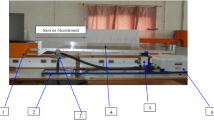Abstract
A one-dimensional mathematical model of water and sediment flow in open channels is proposed based on the forces influencing a water stream and bottom and stream sediments. The equations of water and sediment flow are closed by the equations of continuity of stream, velocity of particle motion in a stream, and the equation of balance of kinetic energy and moving particles: joint calculation of stream hydraulic characteristics and sediment discharge is performed. Hydraulic resistances are retrieved not from the Chezi formula, but based on the balance of forces and kinetic energy. A sediment discharge is calculated from velocities and the number of moving solid particles instead of empirical relationships whose accuracy is usually low. The model is verified against the data of experiments in hydraulic flumes with glass and sand bottom. Comparison with independent data in the glass flume in a wide range of water discharges and bottom inclinations showed a high accuracy of calculation of hydraulic characteristics (relative error is less than 4%). The experimental data showed that the accuracy of sediment discharge calculated by the model exceeds the accuracy of the calculation using traditional empirical formulas.
Similar content being viewed by others
References
V. F. Babkov, N. I. Bikovskii, A. V. Gerburt-Geibovich, and A. Ya. Tulaev, Ground Science and Ground Mechanics (Dorizdat, Moscow, 1950) [in Russian].
N. B. Baryshnikov and I. V. Popov, Dynamics of Fluvial Processes (Gidrometeoizdat, Leningrad, 1988) [in Russian).
P. F. Gorbachev, Formulas of Average Speed (ONTI, Moscow-Leningrad, 1936).
N. S. Znamenskaya, Hydraulic Modeling of Fluvial Processes (Gidrometeoizdat, Leningrad, 1992) [in Russian].
Z. D. Kopaliani, “Hydraulic Modeling in Models of River Channels,” Trudy GGI, No. 361 (2002) [Trans. State Hydrol. Inst., No. 361 (2002)].
V. I. Teplov, “Drag and Roughness Coefficients in a Smooth Prismatic Channel,” in Problems of Hydraulics and Fluvial Processes on Mountain Rivers, Proc. Scientific Council on the Problem “Complex Use and Preservation of Water Resources” (Gidrometeoizdat, St. Petersburg, 1992) [in Russian].
P. P. Chugaev, Hydraulics (Energoizdat, St. Petersburg, 1982) [in Russian].
A. N. Kondratyev, “Distribution of Bedload Alluviums Discharge on Width of Riverbed at Passing Mesoform,” in NATO ARW. Stochastic Models of Hydrological Processes and Their Applications to Problems of Environmental Preservation (Moscow, 1998).
A. B. Shvidchenko, “Incipient Motion of Streambeds,” Ph. Doctoral Dissertation (University of Glasgow, Glasgow, UK, 2000).
Author information
Authors and Affiliations
Additional information
Original Russian Text © M.V. Shmakova, A.N. Kondrat’ev, 2008, published in Meteorologiya i Gidrologiya, 2008, No. 6, pp. 81–88.
About this article
Cite this article
Shmakova, M.V., Kondrat’ev, A.N. A mathematical model of water and sediment flow in open river channels. Russ. Meteorol. Hydrol. 33, 394–399 (2008). https://doi.org/10.3103/S1068373908060083
Received:
Published:
Issue Date:
DOI: https://doi.org/10.3103/S1068373908060083




